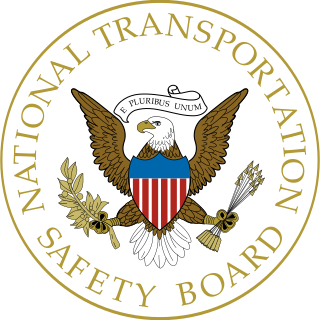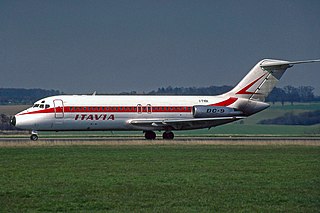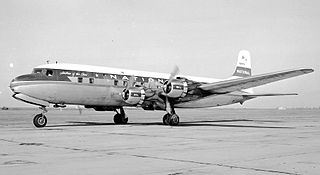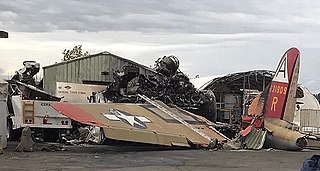Aspects of conspiracy theories
Explosive residues
As wreckage was recovered, preliminary testing indicated the presence of explosive residue on three samples of material from three separate locations of the recovered airplane wreckage (described by the FBI as a piece of canvas-like material and two pieces of a floor panel). [3] : 118 These samples were submitted to the FBI's laboratory in Washington, D.C., which determined that one sample contained traces of cyclotrimethylenetrinitramine (RDX), another nitroglycerin, and the third a combination of RDX and pentaerythritol tetranitrate (PETN); [3] : 118 these findings received much media attention at the time. [7] [8] While investigators from the FBI viewed these positive tests as strong indications of a criminal act, the NTSB was more cautious, noting the lack of any patterns on the recovered wreckage characteristic of an explosion.
Ultimately, the NTSB was unable to determine the exact source of explosive residues found on the wreckage. Some of the possibilities considered were contamination from the aircraft's use in 1991 transporting troops during the Gulf War or its possible use in a dog-training explosive detection exercise about one month before the accident; [3] : 258–259 however, the lack of any other corroborating evidence associated with a high-energy explosion led the NTSB to conclude that "the in-flight breakup of TWA flight 800 was not initiated by a bomb or missile strike". [3] : 259
Meanwhile, TWA chief 747 pilot Robert Terrell Stacey, who was participating in the official investigation as a TWA representative, became convinced that a reddish-brown substance observed on the backs of recovered passenger seats was suspicious, and possibly indicative of explosive residue or rocket fuel. Working with journalist James Sanders, and Sanders' wife Elizabeth, a TWA flight attendant, he removed items from the wreckage reconstruction site, specifically the samples of seat fabric as well as documents related to the investigation. [9] In 1997 Sanders' published the book The Downing of TWA Flight 800, in which he proposed that TWA 800 had been downed by a missile, and that a government cover-up had taken place so as to not panic the public. Later, with the information provided by Sanders, the Riverside Press-Enterprise published a series of articles alleging that the substance was consistent with unexpended rocket fuel from a missile that struck TWA 800. [10]
The NTSB determined the locations and appearance of the substance found on the seatbacks was consistent with adhesive used in the construction of the seats, and additional laboratory testing by NASA identified the substance as being consistent with those adhesives (results which Sanders disputed). [3] : 118
On December 5, 1997, federal prosecutors charged Sanders, his wife Elizabeth, and Stacey with theft of government property. [11] The Sanders' defense attorney Bruce Maffeo described the prosecution as "extremely vindictive" and insisted that the couple had a First Amendment right to take the sample and crash-related documents to expose a cover-up. [12] In April 1999, both were convicted of stealing evidence from civil aircraft wreckage, and were sentenced to probation (Stacey had previously pleaded guilty to a misdemeanor in the case). [12] In 1999, James Sanders authored a second book, Altered Evidence.
Radar data
| | This section needs expansionwith: background of radar coverage of TWA 800's flightpath. You can help by adding to it. (April 2011) |
Unidentified radar tracks
One of the first widely reported criticisms of the official investigation was by former White House Press Secretary and ex-Senator Pierre Salinger, who held a press conference in Cannes, France, on November 7, 1996. He stated he had proof that TWA 800 was shot down by friendly fire, and the incident was being covered up by the government. [13] Salinger said "he was basing the claims on information he saw in a document given to him six weeks ago by someone in French Intelligence with close contacts to U.S. officials", [13] but refused to name his source. CNN quickly found Salinger's document to be "a widely accessible e-mail letter that has been circulating for at least six weeks on the Internet's World Wide Web." [13] Salinger's evidence was actually an e-mail from Richard Russell, a retired airline pilot. [14]
Salinger's previous position as White House Press Secretary, as well as longtime correspondent for ABC News, initially gave credence to his statements, transforming them from "internet conspiracies" into the mainstream. [14] However, under scrutiny, his allegations, and the reports issued with his collaborators, became the subject of much criticism in the media. [15] [16] NTSB Vice chairman Bob Francis was quoted as saying "He was an idiot, he didn't know what he was talking about, and he was totally irresponsible." [14] Supporters of Salinger's view included former chairman of the Joint Chiefs of Staff Thomas Moorer, who took out a full page ad in the New York Times and called for a new Congressional hearing. [17]
TWA 800 flightpath after explosion
| | This section needs expansionwith: TWA 800 flightpath before fireball. You can help by adding to it. (April 2011) |
Ray Lahr
Another proponent of the U.S. Navy shootdown theory and prominent critic of the zoom climb scenario was H. Ray Lahr, a retired United Airlines pilot. Lahr, recipient of the Laura Taber Barbour Air Safety Award by the Flight Safety Foundation in 1994, [18] filed a Freedom of Information Act (FOIA) suit in U.S. District Court, Central District of California, Western Division, on November 6, 2003, against the NTSB and CIA. [19] [ non-primary source needed ] Lahr sought documentation and data denied to him through previous FOIA requests that the NTSB and CIA used for their calculations of the zoom climb, which was used to produce the CIA animation. [19] When asked for his reasons for seeking these documents, Lahr stated "I believe that I could show that the zoom climb never happened. If the zoom climb never happened then they've got to find out what the eyewitnesses saw and the only logical conclusion there is that they saw a missile." [20]
On August 31, 2006, the District Court issued an initial ruling that the evidence submitted by Lahr as justification for his FOIA lawsuit was "sufficient for the plaintiff to proceed based on his claim that the government acted improperly," [21] and that Lahr should be granted access to some, but not all, of the documents he was seeking, based on the FOIA statutes and case law. [21] In a further ruling on October 4, 2006, the court finalized the list of documents that the NTSB and CIA must provide to Lahr (again granting some, but not all, of his FOIA requests). [22] While the court reaffirmed its previous ruling that Lahr had provided proof "sufficient to suggest that the government acted improperly", it also clarified that this "conclusion is based on a characterization of the evidence in a light most favorable to the plaintiff, but does not reflect or constitute any finding by the court." [22] Upon being handed this verdict by the court, the agencies involved claimed the documents had been "lost" and could not be located, according to the plaintiff. [23]
Bolide strike
A theory was posited in 1997 by Michael Davis, an American amateur geologist, that a bolide exploded near the airplane. A bolide is a large meteoroid, explosively torn apart as it hits the atmosphere. Davis proposed that the mysterious streak observed just before the explosion was the meteoroid's entry path, moments before it blew apart. At least one of the resulting pieces of the exploding meteoroid could have penetrated the fuselage and ripped through the almost empty central wing tank, destroying the wing's structural integrity before exiting the other side. "The damage to the CWT seems to start at the center and work its way forward along a discernible path. A fuel explosion would radiate damage in all directions." The vapor in the fuel tank could have ignited due to the searing heat produced by the bolide's high velocity. Other data appear to fit the hypothesis; the sequence of multiple sonic booms heard by witnesses onshore could be explained by the explosion and subsequent scattering of the heavier bolide remnants; the estimated 200 holes in the fuselage (cited in FBI report) could be indicative of metal cut by objects traveling at extremely high speed.[ citation needed ]
Although raising an interesting possibility, other scientists dismissed this theory due to the extremely low probability of a bolide's intersecting the aircraft's flight path at precisely the required moment. [24]
Electromagnetic interference
On April 9, 1998, Elaine Scarry's article in The New York Review of Books , titled "The Fall of TWA 800: The Possibility of Electromagnetic Interference", was published. Scarry, a professor of English and American Literature and Language at Harvard, proposed that electromagnetic interference, also referred to as "High Intensity Radiated Fields" (HIRF), could have been the cause of the TWA 800 crash, specifically energy emitted from a U.S. military craft. [25] Later that year, The New York Review of Books published a series of letters between Scarry and NTSB Chairman James Hall discussing the possibility of HIRF being causal to the accident, and what steps the NTSB was taking in its investigation to determine if it was a factor. [26] [27]
After the adoption of the final report, Scarry published another article in the New York Review of Books titled "TWA 800 and Electromagnetic Interference: Work Already Completed and Work that Still Needs to be Done". [28] While praising the initial research done by the NTSB into HIRFs, she also stated that much more additional research was needed. [28] Scarry criticized what she felt was a bias in the investigation to the "meticulous" detailing of events inside the airplane, while not fully exploring the electromagnetic environment outside the airplane. [28] Scarry focused on a U.S. Navy P-3 Orion close to TWA 800 as being a possible source of electromagnetic interference and cause of the CWT explosion on TWA 800. [28]
Scarry has since written about Swissair Flight 111 and EgyptAir Flight 990 crashes in connection with electromagnetic radiation. [29] [30]

















